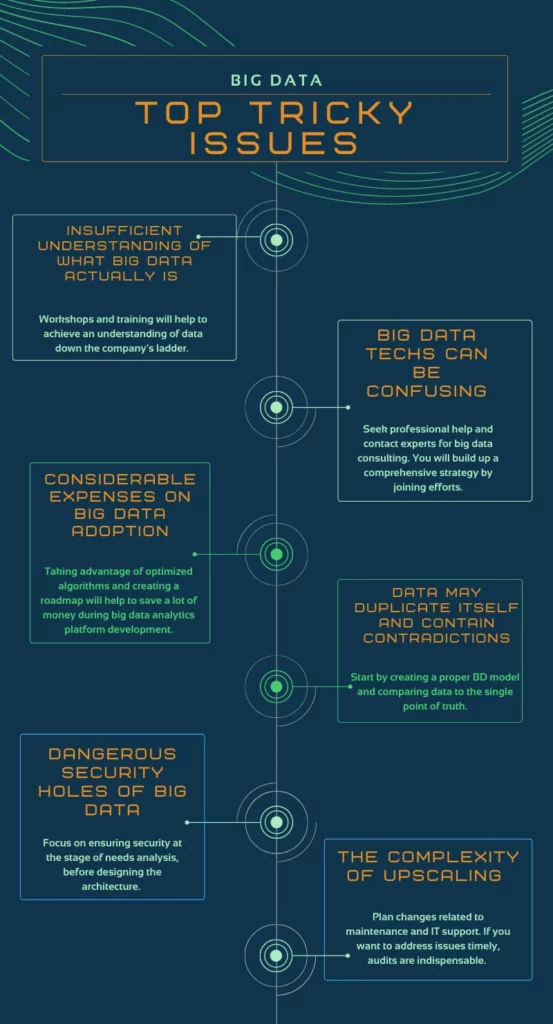How to prevent issues with Big Data Analytics?


Over 90% of global data was created in the past two years, which proves the massive demand for big data analytics systems. Despite this fact, only 27% of entrepreneurs consider their big data practices a successful initiative.
So, what conclusions can be drawn from these statistics? Foremost, there’s a significant gap between a theoretical understanding of big data analytics and putting the ideas into practice. The root of these problems also lies in a lack of in-depth knowledge of what big data is and how it works.
To start with, big data comprises data sets, which have enhanced the ability to capture, process, and manage information with low latency. This technology has three distinctive features:
Big data analytics refers to the process of collecting, processing, and analysing large and complex datasets to extract valuable insights, patterns, trends, and other relevant information. It involves using various techniques and technologies to handle data that is too massive,

Nowadays, big data analysis is in demand because it allows industries to work with different information from numerous devices, sensors, networks, log files, and video/audio. And usually, a multitude of real-time data is generated at a large scale. Another reason why sources have become more complex is the integration of Artificial Intelligence and the Internet of Things. Whether you use dig data only or combine it with traditional data, you obtain faster decision-making, data processing, modelling, and predicting future outcomes.
The list of industries using big data regularly is highly varied:

Big data adoption projects may come to nought if enterprises don’t accept the concept. To avoid spending plenty of time and resources on unnecessary functions, top management should first accept analytics software for business. Workshops and training will help to achieve an understanding of data down the company’s ladder.
The bunch of cutting-edge techniques brings companies not only benefits but also challenges. Do you need to store information in HBase or Cassandra? Whether Spark is an appropriate option in your case? We advise you to seek professional help and contact experts for big data consulting.
Even if your company opts for a cloud-based system, you will need to pay for cloud services and hire administrators and developers. You will also be responsible for the required frameworks’ maintenance. Another area of concern is future expansions, so take them into account as well.

Please remember that big data isn’t 100% accurate. Even so, it would be best if you kept up controlling your data’s quality and reliability. We suggest you start by creating a proper BD model and compare data to the single point of truth (as an example, you can look at variants of addresses and compare them with ones you found in the postal database.
Oftentimes, big data adoption teams tend to solve security issues during later stages. As a result, data analytics for businesses is becoming vulnerable. Focus on ensuring security at the needs analysis stage before designing the architecture. Getting along with security issues from the very beginning enables developers to design efficient IT solutions for businesses.
Keeping your company’s performance effective is critical without exceeding the available budget and resources. Make sure your architecture is decent. While creating big data algorithms, bear in mind the upcoming upscaling. Plus, always plan changes related to maintenance and IT support. And finally, conducting systematic performance audits.
If you need to dive into the topic further and discuss big data technologies, feel free to contact our team in the form below.